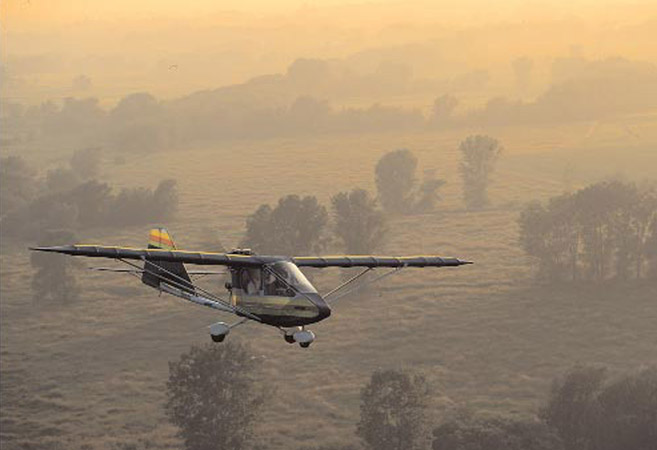
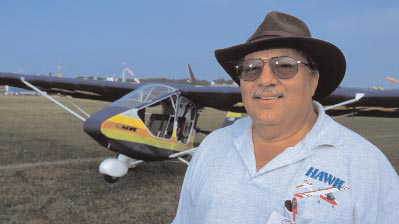
Some aviation figures are larger than life. Some are just large. Chuck Slusarczyk is both. And no story about the Hawk ultralight line is complete without talking to the man from Ohio.
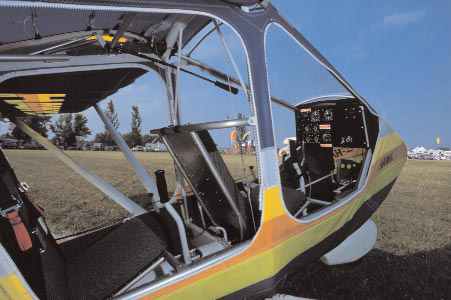
Today, the CGS Hawk Arrow II represents the latest evolution of this long-standing design. Chuck says the Arrow II is currently the most popular model sold by his company. It maintains its ultralight origins with Dacron covering, zippered doors, and basic instrumentation.
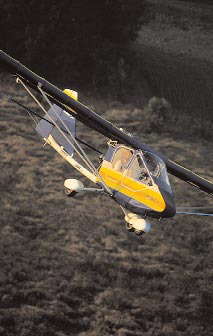
CGS Aviation Hawk Specifications
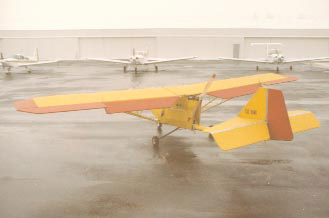
Above, with flaps and three-axis controls, Chuck’s Hawk was revolutionary in the powered hang glider/ultralight world.
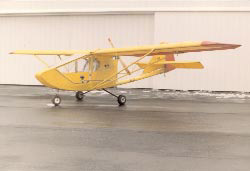
Above, the prototype CGS Hawk built in 1982. Note that the aircraft is N-numbered, N57CS. At that time, FAR Part 103 had not been finalized to establish ultralights as a recognized category.

Chuck gets ready for a flight in his powered Easy Riser at the Cleveland Air Show in 1978. Note the belt reduction drive on the back of the engine. On August 26, 1979, Chuck flew this aircraft across Lake Erie to set a record as the first powered hang glider to fly across the lake. Today, this machine hangs from the ceiling of the Cessna Restoration Center in the EAA AirVenture Museum, honoring that feat.
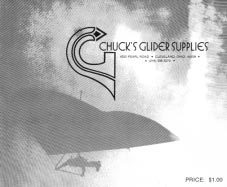
One of Chuck’s Glider Supplies’ early catalogs. Established in 1970, Chuck’s Glider Supplies was the largest manufacturer of hang gliders in the Midwest. The “CGS” of his company’s current name, CGS Aviation, refers to that original company.

The first production model belt-drive reduction unit mounted on an Easy Riser. Chuck had experimented with chain-belt drives, cog-belt drives, and two-belt drives before settling on this three-belt version.

Above, Chuck Slusarczyk’s interest in personal flight developed with hang gliders. He began designing hang gliders in 1970. Here he flies his Falcon V hang glider at Kitty Hawk, North Carolina, in 1975 at the second hang gliding meet held on the dunes just south of the Wright Brothers Memorial. (courtesy Chuck Slusarczyk)

A look at CGS Aviation and its Roots
The Hawk and Chuck. Chuck
and the CGS Hawk. They are
absolutely intertwined. While
Chuck has a wife, Pixie (aka Nancy),
and family—four sons (Chuck Jr.,
David, Ted, and Don)—he has
another family in his aircraft.
Going Way Back
Our story this month takes us back
in time. EAA recently celebrated the
induction of Michael Sacrey into the
Ultralight Hall of Fame. He was
present near the beginning of the
movement. But even before
ultralights were officially recognized
as a segment of aviation, Chuck was
doing essentially what he is doing
today—selling flying machines.
In the early days, Chuck built
hang gliders, with names like the
Swooper, Spitfire, and Falcon (models
I through VII). While hang gliding
was most popular on the West Coast
and many major hang glider
manufacturers were located there,
hang gliding was also popular along
the dunes of the Great Lakes, and
Chuck’s operation was one of the
biggest in the eastern part of the
country. In fact, the company’s name
today, CGS Aviation, comes from its
former name: Chuck’s Glider
Supplies. In those formative days,
businesses like Chuck’s Glider
Supplies were less involved in
manufacturing and more involved in
selling a lifestyle. Hang gliders sold
like surfboards, so enterprises like
Chuck’s Glider Supplies were more
like shops than factories.
Chuck Slusarczyk and I go back a
long way. Before ultralights were
around, he and I were separately
involved with the manufacture of
hang gliders. When I entered the
hang gliding scene in 1973, Chuck
was already a figurehead in that
community of aviators (as was Tom
Peghiny, who’s now the president of
Flightstar Inc.).
Later, like many of his fellow
designers, Chuck started
experimenting with engines for his
hang gliders. Eventually he began
using the Easy Riser bi-wing hang
glider as the airframe for his tiny little
powerplants. In the late 1970s, 10
horsepower had to suffice (luckily,
Chuck himself represented less
payload then).
As hang gliders evolved into
ultralights, the need for power…and
more power…developed. That was
long before Rotax, and its
predecessor, Cuyuna, were known in
aviation, and before engines became
a separate industry. To get power on
your machine, you bought and tried
whatever engines you could find,
with the Mac 101 chain saw engine
being one popular choice. You, as the
builder, had to figure out the engine
mount, muffling, and cooling parts.
And, remember, the engines had to
be light because the airplanes were
light—they still had to be foot
launched—so the choices were fewer.
Chuck helped that early ultralight
industry by being one of the first to
sell power kits so that enthusiasts
could build their own self-launched
hang gliders. But he did more than
that. He also helped the industry by
being a trailblazer.
Rule Breaker
In the early 1980s the rule defining
powered hang gliders stated the
machines had to be foot launched.
FAR Part 103 had not yet been
released when the CGS Hawk first
found its way to market. However, the new rule
was coming, and hints about its
exact content were fodder for hangar
talk across the country. Until Part 103
was enacted, the machines had to
have access on the underside of the
carriage for the pilot’s legs to extend
out. Then, factory he-men would
demonstrate that the machine could
be foot launched by staggering into
the air, usually in strong winds that
helped lift the aircraft.
In 1982 when CGS introduced the
Hawk at Sun ’n Fun, it was the first
fully enclosed ultralight. There was
no way to put your feet through the
bottom of the airframe onto the
ground; therefore foot launching was
impossible. Technically Chuck’s
machine was illegal.
“How does he dare flout the rule?”
many asked. In fact, two
manufacturers filed a protest with
FAA at that fly-in to have Chuck’s
plane grounded. When Chuck told
the investigating FAA officials that he
had N-numbers for the machine, but
that he had been directed by an
inspector from the Cleveland FAA
office to simply fly the machine as
ultralight because the rule was
imminent, FAA agreed to let Chuck
fly. History shows that his brazen
move was successful when Part 103
defined ultralights and allowed
enclosed vehicles like the Hawk. But
this was only one triumph in a
long series of Chuck’s
trailblazing ideas.
The Hawk was also
the first ultralight to
incorporate conventional
three-axis controls,
including a steerable nose
wheel or tail wheel. You
may see these design
features as common, and
today they are; remember,
however, that ultralights
were born of powered hang
gliders, which used only control bars.
Accordingly, the early control systems
of ultralights were nothing less than
amazing in their simplicity and
diversity. Having worked in the
conventional aviation industry for a
period of time, Chuck knew standard
control systems, and he saw an
advantage in providing them in
ultralights. The company’s steady
sales for the past two decades are a
testament to the accuracy of his
vision.
Hawks were also the first
ultralights to use fully functional
wing flaps and full strut bracing.
Again, standard stuff, you may think,
but flaps were very uncommon in the
early 1980s, and someone had to
break new ground.
Those who lead are carefully
watched by those who follow.
Leading a development places you on
the radarscope of those behind, and
while they catch up, they can observe
the leader’s successes and mistakes.
With the Hawk, the market liked
what it saw, and so did EAA fly-in
judges, who named Chuck’s Hawk
the “Best New Design” of 1982 at Sun
’n Fun. That same year the new bird
also won “Outstanding New Design” at EAA Oshkosh ’82.
And a year later at the same event,
the Hawk won the prestigious
DuPont Kevlar ARV (air recreational
vehicle was the buzzword of the day)
Design Competition, beating a field
of 126 ARV designs.
Reduction Drives
Even before introducing the Hawk,
Chuck had been one of the first to
use a reduction drive with his engine
and propeller combination,
eliminating the screamingly loud and
power-inefficient direct drive props of
the first ultralights. Again, these early
machines were basically hang gliders
with engines added to provide lift to
get the machine aloft. Then the pilot
would shut down the engine and
soar. If the machine was noisy for a
few minutes of climb, well, that was
the price you paid…and at least the
powerplants were lighter. Neighbors,
of course, looked at the noise
differently.
Chuck realized that by using a
reduction drive he could dramatically
increase usable thrust and offer
quieter operations at the same time,
so he created a belt-drive reduction
system. Because he was the first
to use this on powered hang
gliders (they weren’t yet called
ultralights), he was awarded a
patent (#4,262,263 “Powered
hang glider with reduction
drives”). At one time Chuck
supplied 80 percent of all
reduction drive systems sold in
the United States. Though he
tried to collect royalties on his
patent, the ultralight industry
was not mature in those early
days, and all Chuck got was fame
for his efforts. However, his work
paved the way for the modern
ultralight in several significant
ways, and for that Chuck
Slusarczyk was one of the first
ultralight pioneers to be inducted
into EAA’s Ultralight Hall of Fame.
Chuck’s efforts gave CGS Aviation
an advanced, feature-laden, and more
powerful aircraft than many of his
competitors, and this attracted
customers. Once he introduced the
Hawk, Chuck’s leadership in
ultralight aviation kept CGS Aviation
in the forefront of the ultralight
community.
Hawk Enlargement and
Refinement
When I first flew the Hawk back in
1983, CGS only offered one model.
That’s because the ultralight industry
in the early ’80s was much like the
old days of automobile
manufacturing. For example, when
you bought a Chevrolet or Ford then,
you didn’t buy a Ford Taurus LX. It
was simply “a Ford.”
Today, the Hawk has developed
into five basic airplanes with one
additional variation on the theme (an
ag version). All models can be fitted
with a variety of engines, ranging
from the Rotax and Hirth to the HKS,
which are all factory tested and
approved. No scrounging for parts
anymore!
CGS is rare among modern-day
ultralight manufacturers in that it
offers more single-place versions than
two-seaters, in a 3-to-2 ratio. But this
has proven smart based on the sales
figures. More than 1,100 Hawk
singles have sold, compared to
around 450 of the two-seat models.
In the single-place lineup is the
Classic, the Arrow, and the Plus. CGS
can also supply an agricultural
version of the Plus. The two-seaters
are called the Classic II and Arrow II.
The Classic is the older, simpler
plane. When you move up to the
Arrow model for another $1,150, you
get the fuselage featuring the curved
windscreen (rather than the Classic
flat windscreen)
plus streamlined
struts. Sewn into
the Dacron wings
are lower surface
ribs. The Arrow
also has a larger
vertical stabilizer
and rudder plus a
strengthened
boom tube. On
any Hawk model
you can choose
between the
taildragger or
tricycle gear
version. All the
Hawk singleseaters
are priced
with the Rotax 447 engine, which has
proven sufficient for most operators.
The Arrow taildragger is my
favorite CGS offering, but it comes
with two requirements: the machine
must have an N number (because it’s
an experimental amateur-built) and
the pilot must hold a minimum of a
recreational or private pilot certificate
(though the two-seat trainer model
can be operated under an exemption
to Part 103). Despite liking the
creature comforts of the curvier
Arrow, I still admire the simpler
Classic, and I’ve long believed that
lighter ultralights tend to have better
handling and agility than heavier
ones.
The Hawk Classic
uses squared lines and a simpler
structure than the Arrow. This helps it
stay light and within Part 103’s tight
254-pound limit (if carefully built).
Yet big pilots or those who prefer to
wear a helmet (like me) may prefer
the roomier Arrow with its curved
fuselage structural members. The
curved tubes help form the
windscreen’s shape, which gets rid of
a significant glare. Fly with the sun at
your tail, and the Classic’s flat
windscreen is clear and the view
wonderfully large. But turn into the
sun, and forward visibility becomes
restricted at the wrong angles. The
modern, curved upper cockpit
member of the Arrow puts a convex
shape in the windscreen, and the
result is better in bright sun from any
angle.
All the Hawk two-seaters feature
tandem seating; in each, I’d rather fly
from the front seat, but the rear seat
offers decent visibility for passengers.
For a single-person camping trip to a
local fly-in, the Classic II or Arrow II
offers great cargo space. You’ll pay
about $3,000 more for the extra
hardware and larger 503 engine that’s
standard with the II models.
Positioned somewhat in between
the Classic and the Arrow is the CGS
Hawk Plus model, which is basically a
two-seater without the second seat.
This configuration makes the Plus a
bit heavier than the trim Classic II,
yet it offers more space for those who
want to carry items with them. Its
price is midway between the other
singles and two-seat Hawks, but note
that the Plus does not qualify for Part
103 because of its higher empty
weight.
Owner-Pleasing Flier
I’ve spoken to a lot of Hawk
owners over the years. That’s not
difficult, as CGS has sold about 1,500
aircraft, a figure only achieved by a
few other light aircraft producers. Of
course, I’ve heard the usual range of
bellyaches from customers, as is the
case for most ultralight producers. If
you sell 1,500 planes, some folks are
going to have complaints about some
aspect, usually the task of building.
However, I have yet to speak to a
single Hawk owner who griped about
the way the Hawk flies. In fact,
everyone I’ve talked with has been
genuinely happy with the design’s
flight characteristics.
I’ve had the pleasure to fly every
variant of Hawk ultralight CGS has
produced. After the first one, I
anticipated the rest with enthusiasm.
Lifting off in the Hawk has always
been pleasurable. I love the way this
bird takes to the air and returns to
base. I don’t care how many hours a
pilot has, most advanced skills are
enjoyed aloft, doing aerobatics, flying
competitions, soaring, or achieving
long cross-country flights. When any
of these flight experts comes home,
he or she will appreciate an easy-toland
aircraft. The Hawk is one of the
best.
While they aren’t needed on all
landings, the use of full flaps for
landing makes for a very modest
touchdown. Chuck has long
preached that “50 is nifty” to guide
Hawk approach speeds. This yields a
wide safety margin, and I have
achieved approaches that were closer
to 40 mph, which makes for very
short landings of 150 feet or less.
When I experimented with zero flaps
my landings were firmer, so Chuck’s
addition of flaps back in the early ’80s
was a good idea. Like all Hawk
controls, the flaps operate easily,
quickly becoming second nature.
I found roll response in all the
Hawk models to be very good. You
might not call the Hawk “fast
handling,” but that’s actually
preferable for most pilots, and I’ve
never felt a loss of control even in
some stiff crosswinds. Rolling into
turns requires low physical effort and
modest stick movement, while
breakout force, or roll response out of
turns, is more authoritative than
many ultralights.
I also found the Hawks to be very
predictable in pitch; Hawks hold their
trim position comfortably. Despite
this ease, trim is still desirable to cope
with changing conditions. Fortunately, as with its other systems,
Hawk offers trim that works well.
Even if you accept that all the Hawks are great flying machines with wonderful takeoff and landing characteristics, most pilots want to know how they perform. One of the simplest ways to state this is by reviewing the 2001 results of the Second World Air Games and Microlight Championships in Spain. Hawks finished first and second in the single-seat fixed-wing microlight class. Any designer would be proud of such a performance in an aircraft that was 20 years old last month.
Ever since Chuck Slusarczyk
entered the aviation business back in
the 1970s, he has brought his own
unorthodox brand of development.
From his powered hang gliders in the
late ’70s through the introduction of the rule-busting Hawk in the early ’80s, Chuck has probably given more than he has received from the ultralight business. Without him the sport of fun flying would be poorer. Thank goodness Chuck and his indomitable humor have been with us so long.
Long may Hawks fly!


Leave a Reply